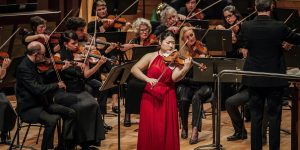Schubert – Rondo in B minor for Violin and Piano, D895 ‘Rondeau Brillante’
Debussy – Sonata in G minor for Violin and Piano, L148
Stravinsky – Suite Italienne for Violin and Piano
Karlo Margetić – ‘On an Imaginary Folksong’ for Solo Violin
Strauss – Sonata in E flat for Violin and Piano, Op.18
Whangarei Music Society’s final event of the 2018 season seemed to warrant a larger venue than the rather cosy Old Library recital room. They opted instead for Forum North’s Capitaine Bougainville Theatre (which always strikes me as the next-best – or rather ‘next-worst’ – thing to an anechoic chamber). Happily, whilst not exactly packed, it wasn’t far short of full. The reason? A visit, courtesy of Chamber Music NZ, of a pair of up-and-coming – or perhaps I should say ‘up-and-come’ – Big Names: the Romanian violinist Ioana Cristina Goicea, winner of the 2017 Michael Hill International Violin Competition, and the Russian pianist Andrey Gugnin, winner of the 2016 Sydney International Piano Competition.
Lest anyone (me, for instance) should mutter, suspiciously, ‘Probably a fluke’, let me hasten to add that, over the last few years, both have reaped stacks of other competitive awards. Still, as the man said, ‘Players who win competitions may simply be good at winning competitions.’ However, that said, my approach is – and has long been – to prove the pudding by the consumption thereof. I’m pleased to say, by the use of this infallible technique the aforementioned man has generally been proven wrong – and ‘generally’ turned out to include this very occasion.
The final two apart, the works in their wide-ranging programme came in chronological order of composition; the first and last item apart, all the works came from the Twentieth Century; and the majority were just nicely off the beaten track. Yet, I would say, none of the Twentieth Century pieces was likely to strike fear into the heart of any member of the legendary ‘blue-rinse set’. Then again, each of the five items represented a distinctive musical style. All in all, this looked a very neat, well-planned and eminently tasty programme.
It just so happens that I’ve just finished reading (for the second time) Gerald Moore’s fascinating autobiography, Am I too Loud? I mention this only because amongst much else he discusses the practicalities of playing instrumental duos, considering the trickiest partner to be a violinist. Why? Because, being constrained by his instrument, he needs to face towards the same side as the pianist but turned slightly towards the audience; in other words, the two cannot maintain ‘eye-to-eye’ communication while playing.
Inevitably, then, as soon as Goicea and Gugnin took their places I couldn’t help this bubbling up in my mind – and lo! during the first few bars I did indeed spot some small deviations from absolute ‘togetherness’. However, this is not a criticism (Heaven forbid!); it merely showed me what Moore was talking about, and incidentally proved that these players were human – real, warm, thinking and feeling human beings.
Many moons have passed since my youth, when the common impression of Schubert was one of (not to put too fine a point on it) simpering, limp-wristed effeminacy. One of the few real things worth cheering about in recent years has been the exposure of Schubert’s chest, as being (almost) as hairy as Beethoven’s. Metric hair-splitting apart, Goicea and Gugnin gave a potent heft and thrust to the opening of Schubert’s Rondo in B minor, D895 (nicknamed Rondeau Brillante), their almost savage outbursts drawing a dramatic contrast with the thoughtfully graduated, lyrical andante melody.
I found the allegro especially captivating; I’ve never been so conscious of Schubert’s almost unruly welter of moods, veering vertiginously from driven to whimsical (and vice versa), extending even to the rumbustious ‘oom-pah’ vamping of some high-class pub pianist. What? In Schubert? Well, yes – the notes are there, but no-one else seems to make this much of them. Powerful as was Gugnin’s piano, not for a second was Goicea’s essentially svelte-toned violin anything less than a match for it, and between them they revelled in the music’s tumult, yet kept a discreet but firm hold on its reins.
How different a proposition was Debussy’s nebulous Sonata in G minor for Violin and Piano, L148, a late work that somehow seems to draw together all the strands of Debussy’s unique style – almost at every turn, the music lures from the back of your mind veiled ghosts of earlier pieces. Goicea and Gugnin played with the utmost respect and sensitivity, unfailingly responsive to Debussy’s ever-shifting dream-world. The first movement emerges from breathless quiet, gradually commixed with diaphanous disturbances. Goicea’s lyric line ascended to just about the softest, sweetest top note I’d ever heard, whilst Gugnin’s pianistic ripples seemed the very embodiment of fluid motion – and with what musicianly skill these two wove Debussy’s sublime tapestry of aural images.
Equally, in the second movement, sliding from soft and sensual to sharply pointed, they elicited the music’s essential puckishness, whilst they made the finale’s rather more hectic flurries sparkle like sunlight glinting through cut glass, and infused the slower passage with languorous expression. I do believe that, if this had been the end of the recital, I’d have gone home feeling that I’d had my money’s worth.
Stravinsky’s neo-classical (or should it be neo-baroque?) Suite Italienne is almost as colourful as the orchestral suite which furnished its materials, which isn’t bad going for just two instruments. It need hardly be said that the music retains its peculiar quality – one foot in the Seventeenth Century, the other planted just as firmly in the Twentieth. To my mind, of all the composers (such as Respighi and Strauss) who’ve tried this sort of trick, Stravinsky is the most effective by a long chalk (and, we might conjecture, paved the way for the likes of Jacques Loussier). I never cease to marvel at his perspicacity, in knowing just when to play it straight, and just when – and how – to play his trump cards. Somehow, he makes his cross-rhythms, syncopations and so on feel not only mildly alarming but also perfectly natural. I get goose-bumps just thinking about it.



